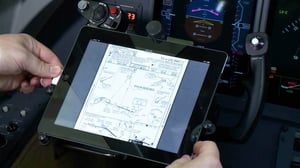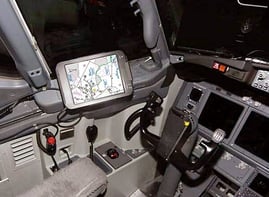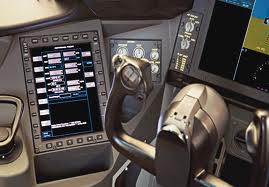Since iPads first were launched by Apple, private pilots flying piston aircraft have quickly grown to love their navigation apps and services available to install and use in the cockpit.
The best apps have replaced bulky paper manuals and allowed pilots to zoom on digital charts and track their progress in flight providing backup to their cockpit instruments.
In the commercial sector the same innovation has taken place. Operators flying commercial jets and turbo props have adopted mobile devices to help them work more efficiently.
Vendors, regulators and commercial operators have adopted the term "Electronic Flight Bag" or EFB, mainly for use in the commercial sector.
This article focuses on EFBs and the specific needs they address.
What is an EFB?
An Electronic Flight Bag is an electronic information management device that increases the efficiency of flight crews' performance of flight management tasks. An EFB electronically stores and retrieves documents required for flight operations, such as operating manuals, aeronautical charts, airport information, route information, weather information, flight logs, and more.
The EFB gets its name from the traditional pilot's fight bag, a document bag carried to the cockpit, which it is replaced with the digital format of these documents.
Not only do EFBs replace paper with electronic versions of required information, but with purpose-built software applications, they can complete functions usually carried out by hand, such as performance take-off calculations. An EFB can be used during phases of flying, including during the flight.

EFB Classifications
The FAA in the USA has defined different Classes of EFB to match their usage in-flight. There are presently 3 classes to consider.
Class 1
Class 1 Devices are fully portable devices that must be stowed during takeoff, landing, and advisedly during periods of turbulence. They are not connected to the aircraft system in any way, and as they are not installed into the aircraft they can be removed without any administrative process.
Class 2
Class 2 devices unlike Class 1 are connected to the aircraft systems, usually mounted in a position where they can be used during all phases of the flight.
Class 3
Whereas Class 1 and 2 are considered Portable Electronic Devices the last class of EFBs are physically installed into the aircraft and therefore require approval.

Class 1 EFB

Class 2 EFB

Class 3 EFB
Software
The FAA has also defined different types of data and information that is exchanged with an EFB in flight.
Type A
Type A relates to pre-composed and static data that does not change during flight, such as flight crew operating manuals and airport NOTAMs.
Type B
This data relates to interactive data, such as approach charts that require panning, zooming, scrolling, or performance calculations during flight.
Type C
This data relates to the same data used in a full MFD (Multi-functional display) as found in a cockpit.
EFBs for Ipad’s and Android’s
There is a good range of EFBs for iPads and Android devices available on the market. Of course, we would recommend RocketRoute but it is important that the reader considering an EFB makes the best choice for their needs.
An iPad or Android EFB can replace much of the Pilot’s carry on flight bag with a quicker, more user-friendly, and compact device, that lessens the Pilot’s amount of paperwork therefore making their job easier. Both of these devices fall under classification 1 meaning that there is no administrative process or installation required when using them.
Benefits of an EFB
Reduces, in some cases eliminates, paper from the Pilot's carry on flight bag and cockpit, decreasing the Pilot's workload.
Faster access to necessary information, increasing Pilot's efficiency in everyday life as well as in emergency situations.
Added software can complete certain calculations, previously completed by hand, reducing the volume of paperwork and removing a lot of the margin of human error.
The software allows accurate takeoff and landing calculations, optimizing fuel consumption and expanding the useful life of aircraft engines.
Onboard calculations can also be completed, improving onboard safety and the efficiency of flying.
The EFB’s ability to complete calculations previously completed by hand is more cost-effective and accurate.
EFBs optimize the exchange of information, enabling Pilots to access the latest operational data straight from the cockpit.
Provides real time weather information improving routing decisions.
The information is fast to send, meaning that flight reports can be sent quickly and efficiently allowing any issues to be addressed much faster than if relying on paperwork being completed and filed.
Storing of all of this necessary flight information in electronic form rids the Pilot and cockpit of hard copies of the documents. This reduction of paper decreases the weight and clutter found in the cockpit as well as to the Pilot’s themselves, lessening health risks.
Typical Documents Found on EFB's
The breadth of information that can be stored on an EFB is impressive. The Best EFBs (including RocketRoute). Provide version control and confirmation of installation. This is particularly useful when documents change month to month.
Example documents that can be synchronized to an EFB for a particular flight are:
- Flight Log
- METAR and TAF Narrow Route Briefing
- NOTAM Narrow Route Briefing
- Winds Aloft Horizontal and Vertical profiling
- Icing
- Significant weather
- Surface weather
- Flight Plan
- Vertical Icing Chart
Here is an example of a briefing that would be available via the RocketRoute EFB.


 METAR and TAF
METAR and TAF
 NOTAM Briefing
NOTAM Briefing
 Icing Chart
Icing Chart


As well as flight-specific information, Electronic Flight Bags can also store static information for example:
- Aircraft Flight Manuals
- Procedures
- Handler/FBO contact details
- Hotel Directories
- Safety Manuals
- Staff Directories
Regulations
US / FAA Regulations
In the US the FAA regulations state that Class 1, Class 2 and Class 3 EFBs may replace the paper manuals that pilots were previously required to carry. Operators not flying for hire are able to approve the use of Class 1 and Class 2 EFBs with their Pilot In Command authority, however in order for operators with OpSpecs to use these classes of EFBs they must seek operational approval.
Clarifying the intent of FAA Advisory Circular AC 120-76A, new draft inspector handbook guidance includes the following requirements:
Portable Electronic Devices (PEDs) used in a Class 1 or Class 2 configuration must meet the rapid decompression testing requirements of standard RTCA DO-160E.
Any data connectivity of PEDs used in a Class 1 or Class 2 configuration to aircraft systems shall be performed in accordance with a Supplemental Type Certificate, Type Certificate or Amended Type Certificate.
Any mounting or attachment of PEDs used in a Class 1 or Class 2 configuration to the aircraft shall be performed in accordance with a Supplemental Type Certificate, Type Certificate or Amended Type Certificate.
Electronic chart software: The display of own-ship position ("spotter") on the ground must meet the requirements of AC 20-159 and/or TSO C-165.
Electronic chart software: The display of own-ship position in flight is prohibited on Class 1 or 2 configurations.

